Criminal Law 22: Homicide, Actus Reus and Mens Rea Analysis
VerifiedAdded on 2022/11/17
|22
|4927
|392
Homework Assignment
AI Summary
This criminal law assignment addresses two primary legal issues: the criminal liability of Carole for the death of Louise and the fulfillment of actus reus by Geoff, Fred, Ian, and Harry. The first question involves a detailed analysis of homicide, distinguishing between murder and manslaughter, and considering partial defenses like loss of control and diminished responsibility, as per the Homicide Act 1957 and the Coroners and Justice Act 2009. The analysis includes the application of these legal principles to the scenario, considering Carole's mental state, the triggering events, and the potential for manslaughter charges. The second question focuses on the concept of actus reus, the physical element of a crime, in the context of a given scenario involving multiple individuals. The assignment applies legal principles and case law, such as Rance v Mid-Downs Health Authority and R vs. Woollin, to determine the liability of each individual. It also considers the roles of causation, intention, and the application of relevant legislation, offering a comprehensive legal analysis of both scenarios.

Running Head: CRIMINAL LAW
CRIMINAL LAW
Name of the Student
Name of the University
Author’s Note
CRIMINAL LAW
Name of the Student
Name of the University
Author’s Note
Paraphrase This Document
Need a fresh take? Get an instant paraphrase of this document with our AI Paraphraser
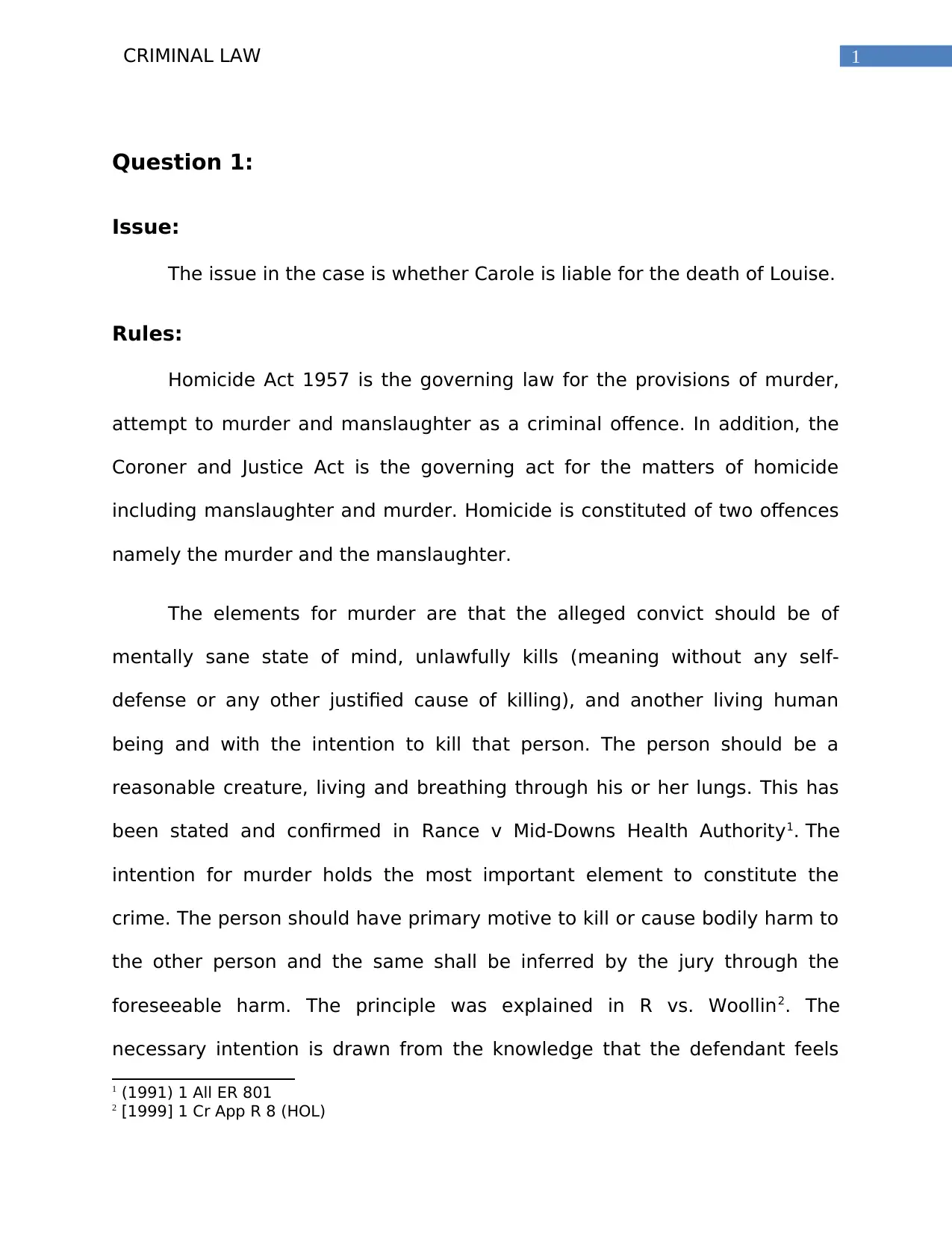
1CRIMINAL LAW
Question 1:
Issue:
The issue in the case is whether Carole is liable for the death of Louise.
Rules:
Homicide Act 1957 is the governing law for the provisions of murder,
attempt to murder and manslaughter as a criminal offence. In addition, the
Coroner and Justice Act is the governing act for the matters of homicide
including manslaughter and murder. Homicide is constituted of two offences
namely the murder and the manslaughter.
The elements for murder are that the alleged convict should be of
mentally sane state of mind, unlawfully kills (meaning without any self-
defense or any other justified cause of killing), and another living human
being and with the intention to kill that person. The person should be a
reasonable creature, living and breathing through his or her lungs. This has
been stated and confirmed in Rance v Mid-Downs Health Authority1. The
intention for murder holds the most important element to constitute the
crime. The person should have primary motive to kill or cause bodily harm to
the other person and the same shall be inferred by the jury through the
foreseeable harm. The principle was explained in R vs. Woollin2. The
necessary intention is drawn from the knowledge that the defendant feels
1 (1991) 1 All ER 801
2 [1999] 1 Cr App R 8 (HOL)
Question 1:
Issue:
The issue in the case is whether Carole is liable for the death of Louise.
Rules:
Homicide Act 1957 is the governing law for the provisions of murder,
attempt to murder and manslaughter as a criminal offence. In addition, the
Coroner and Justice Act is the governing act for the matters of homicide
including manslaughter and murder. Homicide is constituted of two offences
namely the murder and the manslaughter.
The elements for murder are that the alleged convict should be of
mentally sane state of mind, unlawfully kills (meaning without any self-
defense or any other justified cause of killing), and another living human
being and with the intention to kill that person. The person should be a
reasonable creature, living and breathing through his or her lungs. This has
been stated and confirmed in Rance v Mid-Downs Health Authority1. The
intention for murder holds the most important element to constitute the
crime. The person should have primary motive to kill or cause bodily harm to
the other person and the same shall be inferred by the jury through the
foreseeable harm. The principle was explained in R vs. Woollin2. The
necessary intention is drawn from the knowledge that the defendant feels
1 (1991) 1 All ER 801
2 [1999] 1 Cr App R 8 (HOL)
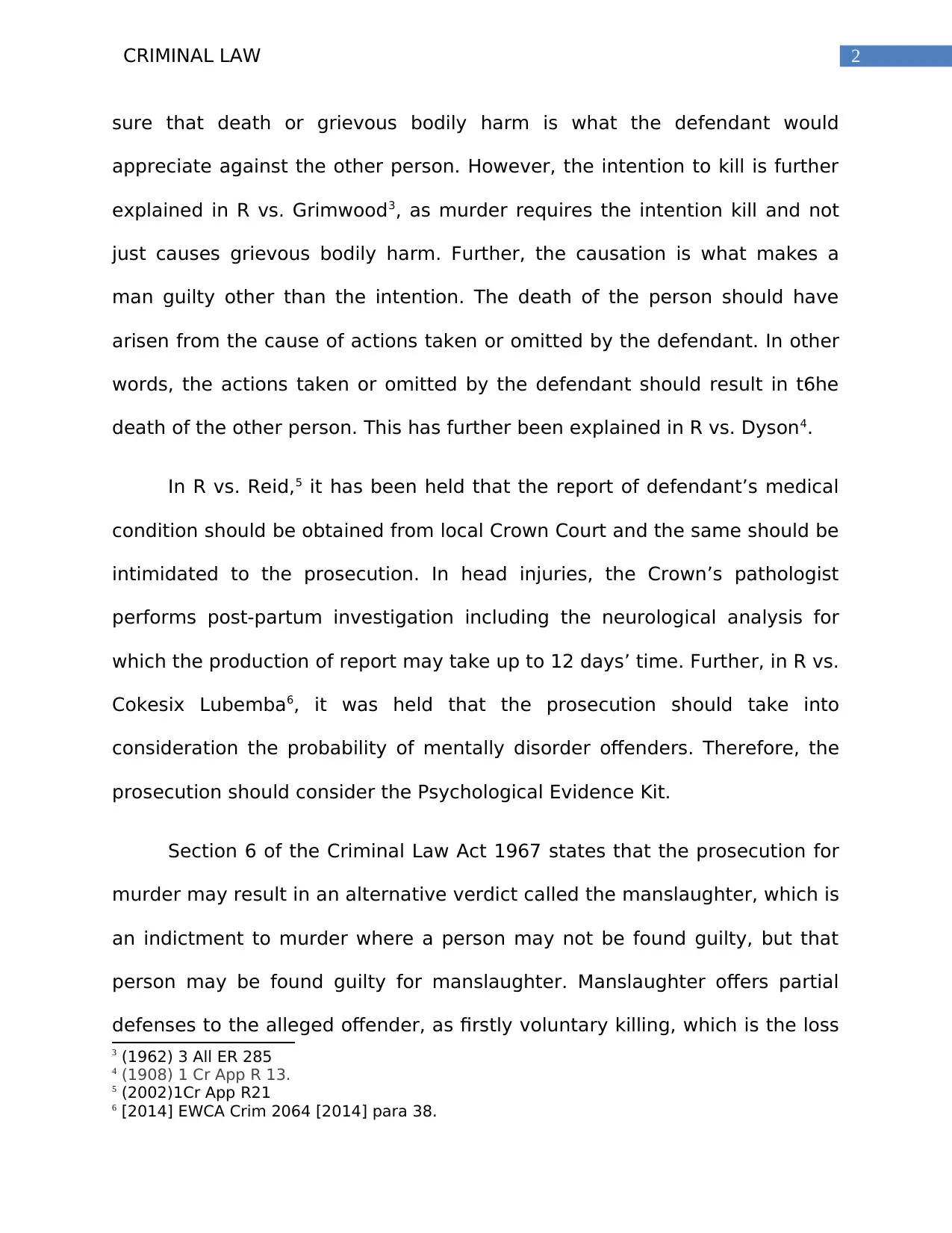
2CRIMINAL LAW
sure that death or grievous bodily harm is what the defendant would
appreciate against the other person. However, the intention to kill is further
explained in R vs. Grimwood3, as murder requires the intention kill and not
just causes grievous bodily harm. Further, the causation is what makes a
man guilty other than the intention. The death of the person should have
arisen from the cause of actions taken or omitted by the defendant. In other
words, the actions taken or omitted by the defendant should result in t6he
death of the other person. This has further been explained in R vs. Dyson4.
In R vs. Reid,5 it has been held that the report of defendant’s medical
condition should be obtained from local Crown Court and the same should be
intimidated to the prosecution. In head injuries, the Crown’s pathologist
performs post-partum investigation including the neurological analysis for
which the production of report may take up to 12 days’ time. Further, in R vs.
Cokesix Lubemba6, it was held that the prosecution should take into
consideration the probability of mentally disorder offenders. Therefore, the
prosecution should consider the Psychological Evidence Kit.
Section 6 of the Criminal Law Act 1967 states that the prosecution for
murder may result in an alternative verdict called the manslaughter, which is
an indictment to murder where a person may not be found guilty, but that
person may be found guilty for manslaughter. Manslaughter offers partial
defenses to the alleged offender, as firstly voluntary killing, which is the loss
3 (1962) 3 All ER 285
4 (1908) 1 Cr App R 13.
5 (2002)1Cr App R21
6 [2014] EWCA Crim 2064 [2014] para 38.
sure that death or grievous bodily harm is what the defendant would
appreciate against the other person. However, the intention to kill is further
explained in R vs. Grimwood3, as murder requires the intention kill and not
just causes grievous bodily harm. Further, the causation is what makes a
man guilty other than the intention. The death of the person should have
arisen from the cause of actions taken or omitted by the defendant. In other
words, the actions taken or omitted by the defendant should result in t6he
death of the other person. This has further been explained in R vs. Dyson4.
In R vs. Reid,5 it has been held that the report of defendant’s medical
condition should be obtained from local Crown Court and the same should be
intimidated to the prosecution. In head injuries, the Crown’s pathologist
performs post-partum investigation including the neurological analysis for
which the production of report may take up to 12 days’ time. Further, in R vs.
Cokesix Lubemba6, it was held that the prosecution should take into
consideration the probability of mentally disorder offenders. Therefore, the
prosecution should consider the Psychological Evidence Kit.
Section 6 of the Criminal Law Act 1967 states that the prosecution for
murder may result in an alternative verdict called the manslaughter, which is
an indictment to murder where a person may not be found guilty, but that
person may be found guilty for manslaughter. Manslaughter offers partial
defenses to the alleged offender, as firstly voluntary killing, which is the loss
3 (1962) 3 All ER 285
4 (1908) 1 Cr App R 13.
5 (2002)1Cr App R21
6 [2014] EWCA Crim 2064 [2014] para 38.
⊘ This is a preview!⊘
Do you want full access?
Subscribe today to unlock all pages.

Trusted by 1+ million students worldwide

3CRIMINAL LAW
of control and other, is the involuntary killing involving diminished
responsibility and pursuant to the pact of suicide. The first element explains
the loss of control wherein Section 54(1)(a)(b) and (c) of Coroners and Justice
Act 2009, states the following three components to constitute the defense:
Loss of control means the actual control lost by the party, which
led to the act committed or omitted.
Triggering point means, the gravity of the act committed or
words spoken that led to the commission or omission of an act.
In R vs. Clinton and Others,7 it was held by the court that the
prosecution should take into consideration the gravity of the
circumstances and the degree to which the plaintiff leading to
the justifiable conclusion made by the defendant that he has
been seriously wronged and that he should now react wronged
the defendant.
Objective test to ensure age, sex, tolerance potentiality by any
other reasonable man. In other words, it means that the
potentiality of the defendant should be tested to ensure the
tolerance capacity of any reasonable man in the given situation
so that the quantum of reaction may be assessed by the court.
7 [2012] EWCA Crim 2, at para.11
of control and other, is the involuntary killing involving diminished
responsibility and pursuant to the pact of suicide. The first element explains
the loss of control wherein Section 54(1)(a)(b) and (c) of Coroners and Justice
Act 2009, states the following three components to constitute the defense:
Loss of control means the actual control lost by the party, which
led to the act committed or omitted.
Triggering point means, the gravity of the act committed or
words spoken that led to the commission or omission of an act.
In R vs. Clinton and Others,7 it was held by the court that the
prosecution should take into consideration the gravity of the
circumstances and the degree to which the plaintiff leading to
the justifiable conclusion made by the defendant that he has
been seriously wronged and that he should now react wronged
the defendant.
Objective test to ensure age, sex, tolerance potentiality by any
other reasonable man. In other words, it means that the
potentiality of the defendant should be tested to ensure the
tolerance capacity of any reasonable man in the given situation
so that the quantum of reaction may be assessed by the court.
7 [2012] EWCA Crim 2, at para.11
Paraphrase This Document
Need a fresh take? Get an instant paraphrase of this document with our AI Paraphraser
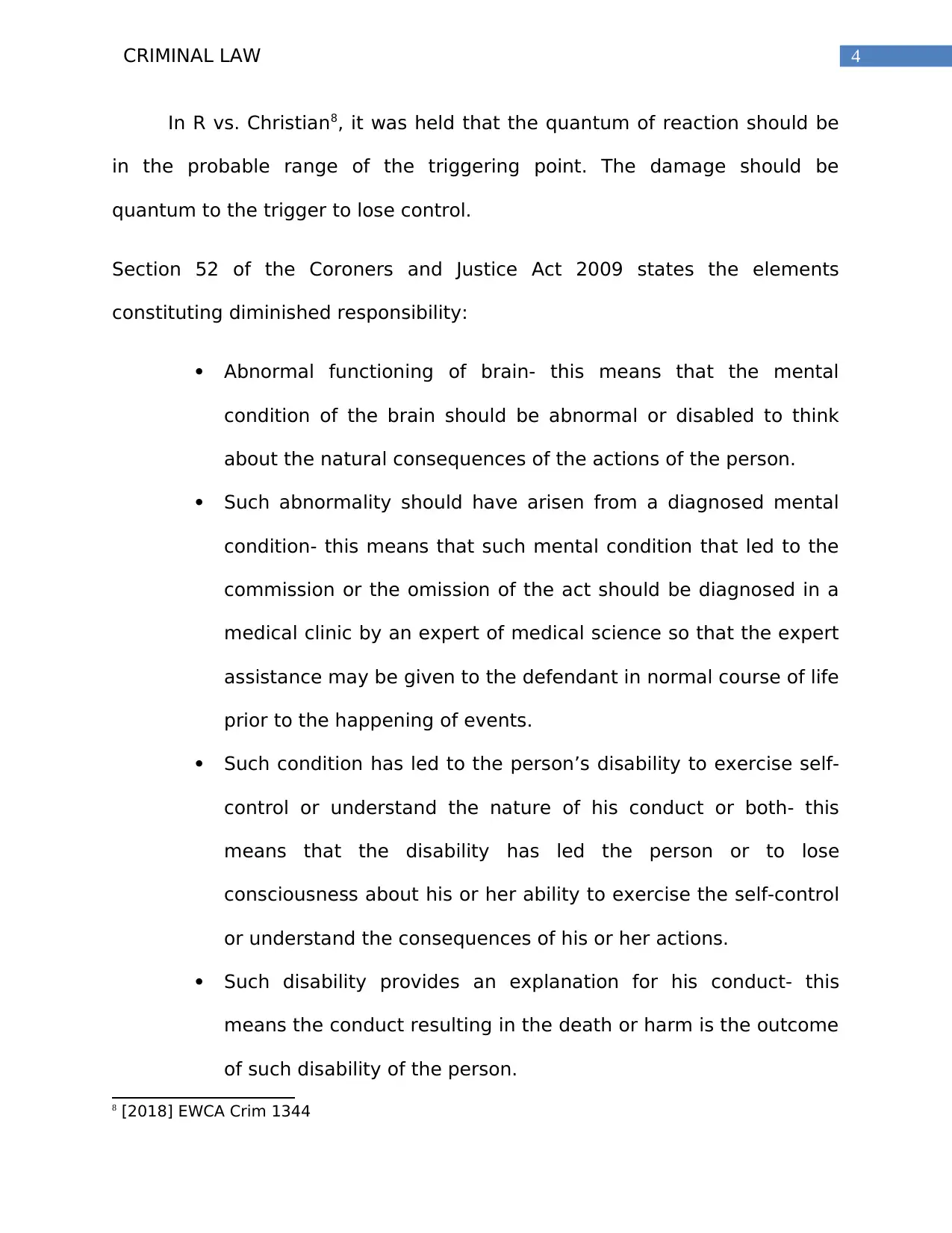
4CRIMINAL LAW
In R vs. Christian8, it was held that the quantum of reaction should be
in the probable range of the triggering point. The damage should be
quantum to the trigger to lose control.
Section 52 of the Coroners and Justice Act 2009 states the elements
constituting diminished responsibility:
Abnormal functioning of brain- this means that the mental
condition of the brain should be abnormal or disabled to think
about the natural consequences of the actions of the person.
Such abnormality should have arisen from a diagnosed mental
condition- this means that such mental condition that led to the
commission or the omission of the act should be diagnosed in a
medical clinic by an expert of medical science so that the expert
assistance may be given to the defendant in normal course of life
prior to the happening of events.
Such condition has led to the person’s disability to exercise self-
control or understand the nature of his conduct or both- this
means that the disability has led the person or to lose
consciousness about his or her ability to exercise the self-control
or understand the consequences of his or her actions.
Such disability provides an explanation for his conduct- this
means the conduct resulting in the death or harm is the outcome
of such disability of the person.
8 [2018] EWCA Crim 1344
In R vs. Christian8, it was held that the quantum of reaction should be
in the probable range of the triggering point. The damage should be
quantum to the trigger to lose control.
Section 52 of the Coroners and Justice Act 2009 states the elements
constituting diminished responsibility:
Abnormal functioning of brain- this means that the mental
condition of the brain should be abnormal or disabled to think
about the natural consequences of the actions of the person.
Such abnormality should have arisen from a diagnosed mental
condition- this means that such mental condition that led to the
commission or the omission of the act should be diagnosed in a
medical clinic by an expert of medical science so that the expert
assistance may be given to the defendant in normal course of life
prior to the happening of events.
Such condition has led to the person’s disability to exercise self-
control or understand the nature of his conduct or both- this
means that the disability has led the person or to lose
consciousness about his or her ability to exercise the self-control
or understand the consequences of his or her actions.
Such disability provides an explanation for his conduct- this
means the conduct resulting in the death or harm is the outcome
of such disability of the person.
8 [2018] EWCA Crim 1344
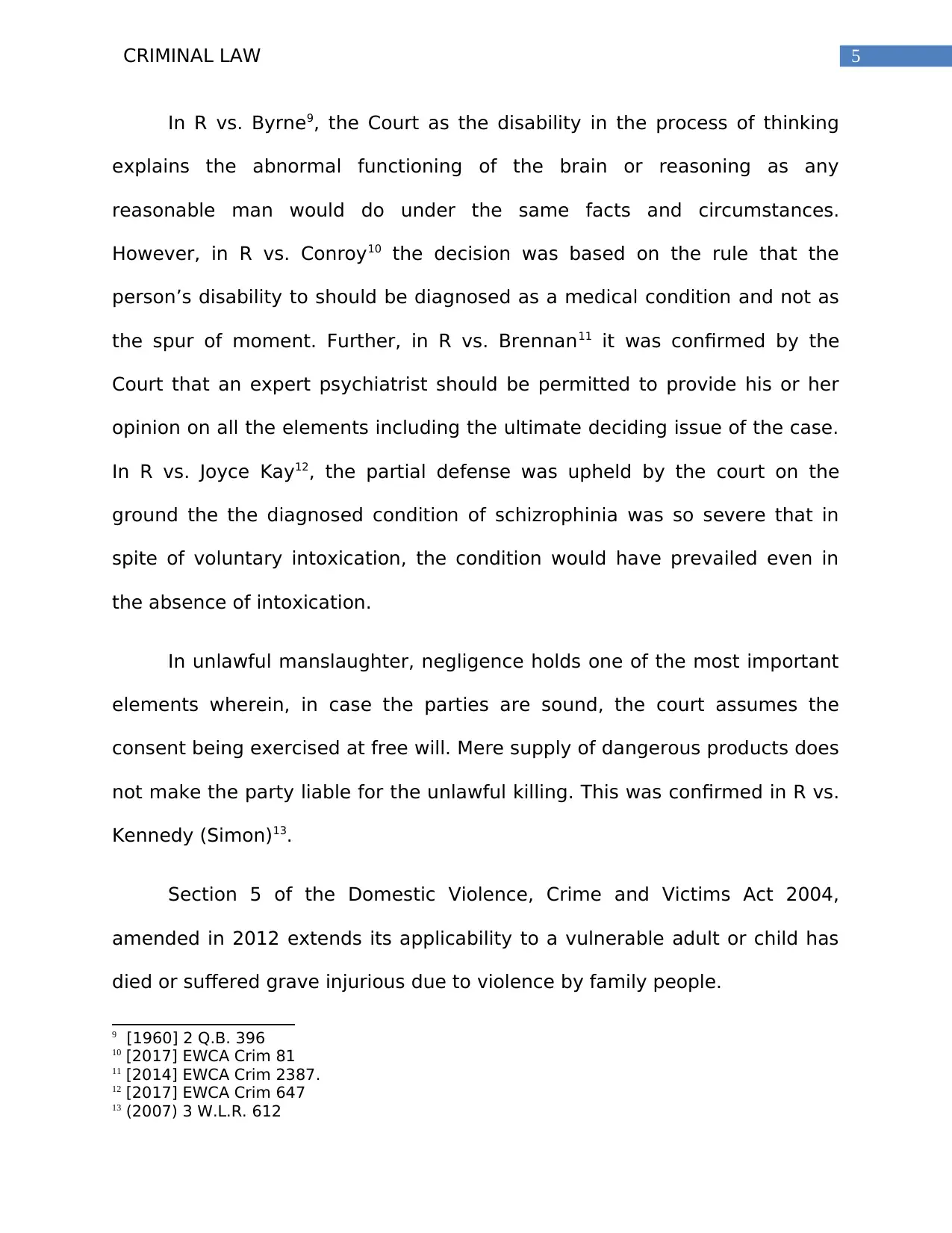
5CRIMINAL LAW
In R vs. Byrne9, the Court as the disability in the process of thinking
explains the abnormal functioning of the brain or reasoning as any
reasonable man would do under the same facts and circumstances.
However, in R vs. Conroy10 the decision was based on the rule that the
person’s disability to should be diagnosed as a medical condition and not as
the spur of moment. Further, in R vs. Brennan11 it was confirmed by the
Court that an expert psychiatrist should be permitted to provide his or her
opinion on all the elements including the ultimate deciding issue of the case.
In R vs. Joyce Kay12, the partial defense was upheld by the court on the
ground the the diagnosed condition of schizrophinia was so severe that in
spite of voluntary intoxication, the condition would have prevailed even in
the absence of intoxication.
In unlawful manslaughter, negligence holds one of the most important
elements wherein, in case the parties are sound, the court assumes the
consent being exercised at free will. Mere supply of dangerous products does
not make the party liable for the unlawful killing. This was confirmed in R vs.
Kennedy (Simon)13.
Section 5 of the Domestic Violence, Crime and Victims Act 2004,
amended in 2012 extends its applicability to a vulnerable adult or child has
died or suffered grave injurious due to violence by family people.
9 [1960] 2 Q.B. 396
10 [2017] EWCA Crim 81
11 [2014] EWCA Crim 2387.
12 [2017] EWCA Crim 647
13 (2007) 3 W.L.R. 612
In R vs. Byrne9, the Court as the disability in the process of thinking
explains the abnormal functioning of the brain or reasoning as any
reasonable man would do under the same facts and circumstances.
However, in R vs. Conroy10 the decision was based on the rule that the
person’s disability to should be diagnosed as a medical condition and not as
the spur of moment. Further, in R vs. Brennan11 it was confirmed by the
Court that an expert psychiatrist should be permitted to provide his or her
opinion on all the elements including the ultimate deciding issue of the case.
In R vs. Joyce Kay12, the partial defense was upheld by the court on the
ground the the diagnosed condition of schizrophinia was so severe that in
spite of voluntary intoxication, the condition would have prevailed even in
the absence of intoxication.
In unlawful manslaughter, negligence holds one of the most important
elements wherein, in case the parties are sound, the court assumes the
consent being exercised at free will. Mere supply of dangerous products does
not make the party liable for the unlawful killing. This was confirmed in R vs.
Kennedy (Simon)13.
Section 5 of the Domestic Violence, Crime and Victims Act 2004,
amended in 2012 extends its applicability to a vulnerable adult or child has
died or suffered grave injurious due to violence by family people.
9 [1960] 2 Q.B. 396
10 [2017] EWCA Crim 81
11 [2014] EWCA Crim 2387.
12 [2017] EWCA Crim 647
13 (2007) 3 W.L.R. 612
⊘ This is a preview!⊘
Do you want full access?
Subscribe today to unlock all pages.

Trusted by 1+ million students worldwide
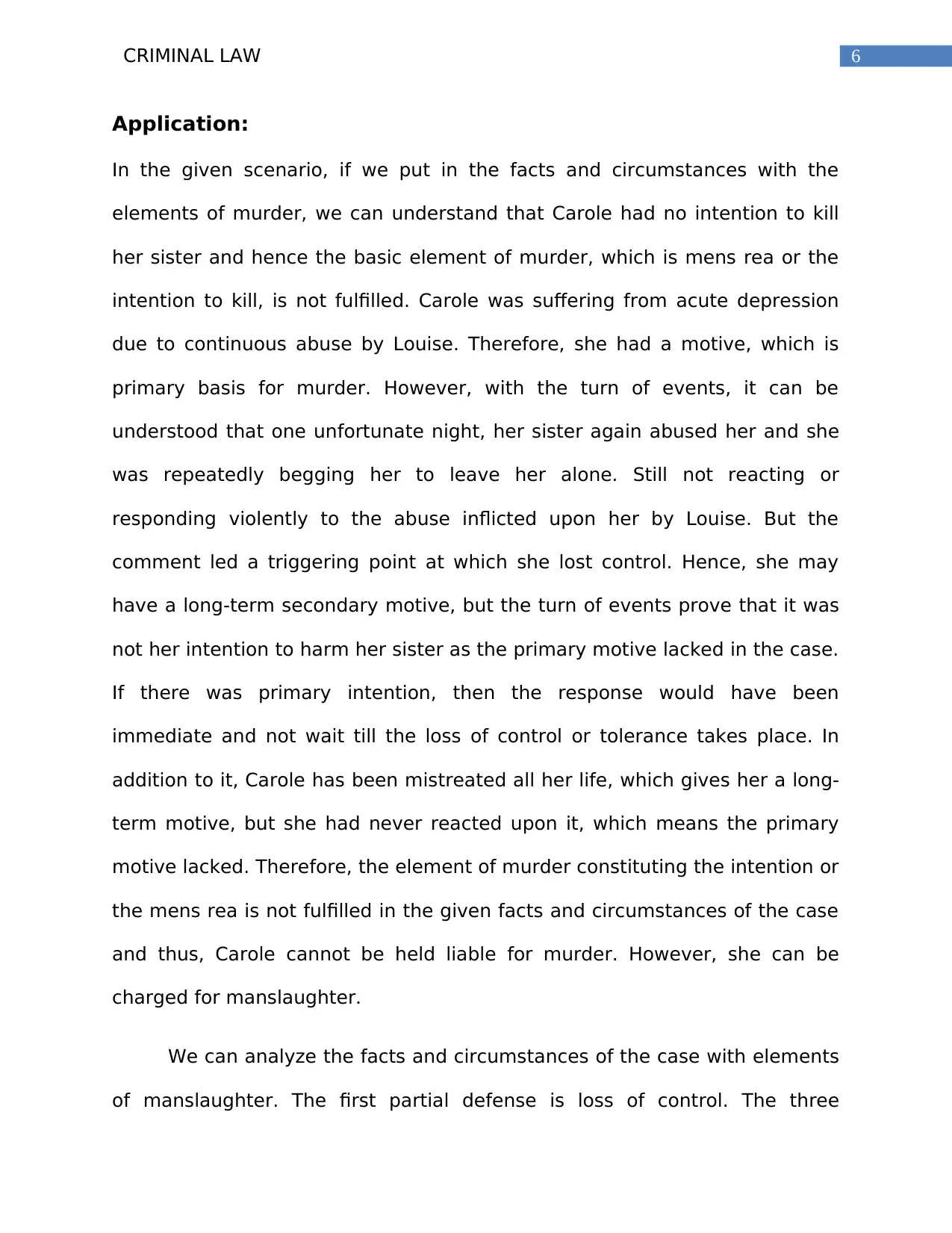
6CRIMINAL LAW
Application:
In the given scenario, if we put in the facts and circumstances with the
elements of murder, we can understand that Carole had no intention to kill
her sister and hence the basic element of murder, which is mens rea or the
intention to kill, is not fulfilled. Carole was suffering from acute depression
due to continuous abuse by Louise. Therefore, she had a motive, which is
primary basis for murder. However, with the turn of events, it can be
understood that one unfortunate night, her sister again abused her and she
was repeatedly begging her to leave her alone. Still not reacting or
responding violently to the abuse inflicted upon her by Louise. But the
comment led a triggering point at which she lost control. Hence, she may
have a long-term secondary motive, but the turn of events prove that it was
not her intention to harm her sister as the primary motive lacked in the case.
If there was primary intention, then the response would have been
immediate and not wait till the loss of control or tolerance takes place. In
addition to it, Carole has been mistreated all her life, which gives her a long-
term motive, but she had never reacted upon it, which means the primary
motive lacked. Therefore, the element of murder constituting the intention or
the mens rea is not fulfilled in the given facts and circumstances of the case
and thus, Carole cannot be held liable for murder. However, she can be
charged for manslaughter.
We can analyze the facts and circumstances of the case with elements
of manslaughter. The first partial defense is loss of control. The three
Application:
In the given scenario, if we put in the facts and circumstances with the
elements of murder, we can understand that Carole had no intention to kill
her sister and hence the basic element of murder, which is mens rea or the
intention to kill, is not fulfilled. Carole was suffering from acute depression
due to continuous abuse by Louise. Therefore, she had a motive, which is
primary basis for murder. However, with the turn of events, it can be
understood that one unfortunate night, her sister again abused her and she
was repeatedly begging her to leave her alone. Still not reacting or
responding violently to the abuse inflicted upon her by Louise. But the
comment led a triggering point at which she lost control. Hence, she may
have a long-term secondary motive, but the turn of events prove that it was
not her intention to harm her sister as the primary motive lacked in the case.
If there was primary intention, then the response would have been
immediate and not wait till the loss of control or tolerance takes place. In
addition to it, Carole has been mistreated all her life, which gives her a long-
term motive, but she had never reacted upon it, which means the primary
motive lacked. Therefore, the element of murder constituting the intention or
the mens rea is not fulfilled in the given facts and circumstances of the case
and thus, Carole cannot be held liable for murder. However, she can be
charged for manslaughter.
We can analyze the facts and circumstances of the case with elements
of manslaughter. The first partial defense is loss of control. The three
Paraphrase This Document
Need a fresh take? Get an instant paraphrase of this document with our AI Paraphraser

7CRIMINAL LAW
elements of loss of defense are fulfilled as Carole lost her control when
Louise made a comment about her. Therefore, the comment was the
triggering point for Carole to commit the act. Further, under the objective
test, we can discuss few points. Firstly, Carole was a victim of regular abuse
by Louise and that unfortunate night, and secondly, Carole repeatedly
begged her to stop bullying and leave her alone. However, she continued her
violence and under these circumstances, any reasonable man would have
reacted. but the quantum of damage can be discussed under the other
partial defense called the diminished responsibility. The elements of
diminished responsibility were satisfied as Carole was suffering from mental
disability, which was diagnosed by the doctors as acute depression. Further,
the mental condition led her to lose control during the incident and hence,
the act was committed due to the loss of control. Furthermore, the crowbar
is a dangerous weapon and it was left at the house by a worker.
Let us analyze if the worker can be held liable for assistance in
manslaughter. In R vs. Evans14, it was held by the Court that the mere supply
of dangerous product or weapon does not make the person liable for the
injury caused due to then use of such weapon provided that the person
receiving such product is an adult and is of sane mind. However, in the given
scenario, the worker did not know that the course of events may take place
14 [2009] EWCA Crim 650
elements of loss of defense are fulfilled as Carole lost her control when
Louise made a comment about her. Therefore, the comment was the
triggering point for Carole to commit the act. Further, under the objective
test, we can discuss few points. Firstly, Carole was a victim of regular abuse
by Louise and that unfortunate night, and secondly, Carole repeatedly
begged her to stop bullying and leave her alone. However, she continued her
violence and under these circumstances, any reasonable man would have
reacted. but the quantum of damage can be discussed under the other
partial defense called the diminished responsibility. The elements of
diminished responsibility were satisfied as Carole was suffering from mental
disability, which was diagnosed by the doctors as acute depression. Further,
the mental condition led her to lose control during the incident and hence,
the act was committed due to the loss of control. Furthermore, the crowbar
is a dangerous weapon and it was left at the house by a worker.
Let us analyze if the worker can be held liable for assistance in
manslaughter. In R vs. Evans14, it was held by the Court that the mere supply
of dangerous product or weapon does not make the person liable for the
injury caused due to then use of such weapon provided that the person
receiving such product is an adult and is of sane mind. However, in the given
scenario, the worker did not know that the course of events may take place
14 [2009] EWCA Crim 650
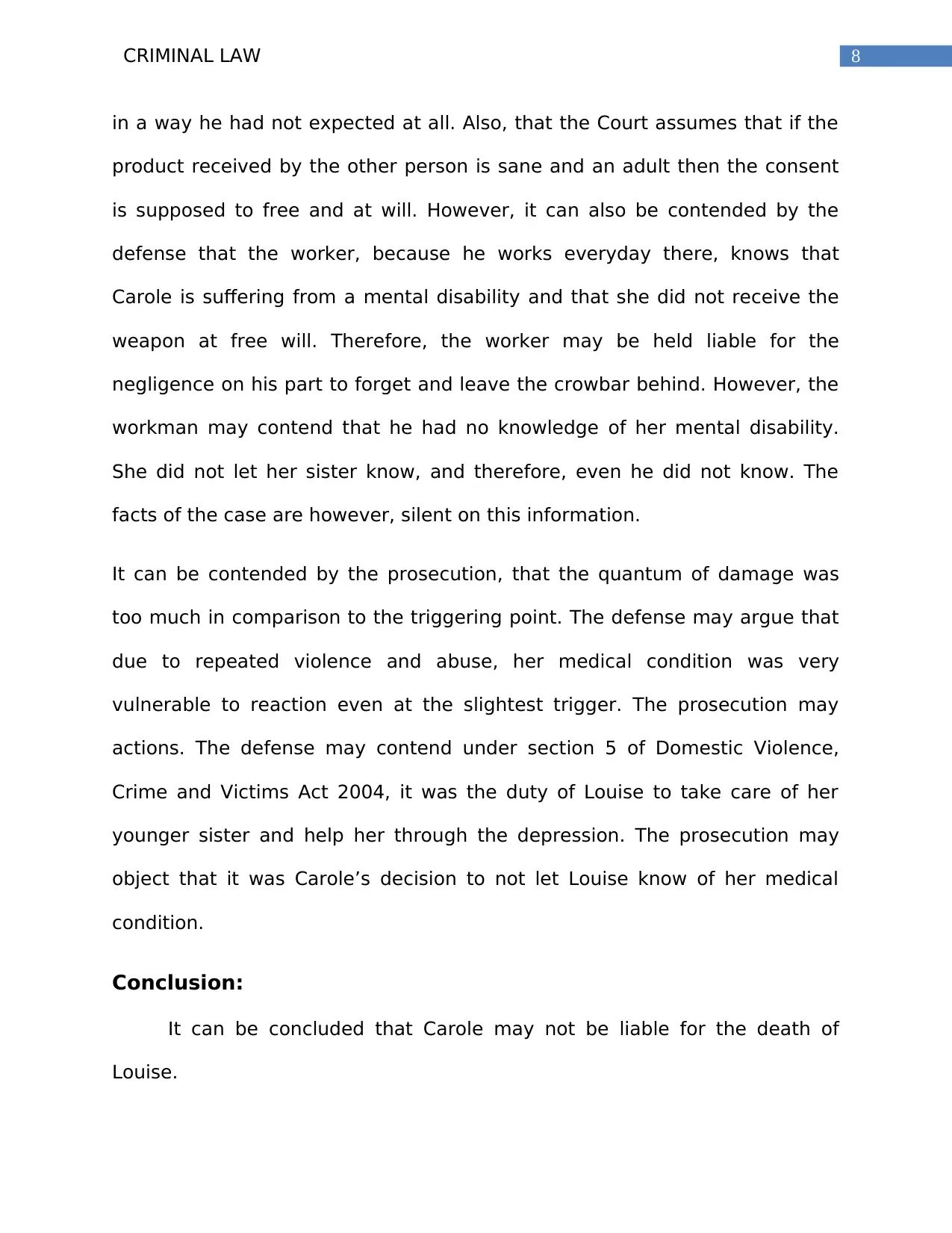
8CRIMINAL LAW
in a way he had not expected at all. Also, that the Court assumes that if the
product received by the other person is sane and an adult then the consent
is supposed to free and at will. However, it can also be contended by the
defense that the worker, because he works everyday there, knows that
Carole is suffering from a mental disability and that she did not receive the
weapon at free will. Therefore, the worker may be held liable for the
negligence on his part to forget and leave the crowbar behind. However, the
workman may contend that he had no knowledge of her mental disability.
She did not let her sister know, and therefore, even he did not know. The
facts of the case are however, silent on this information.
It can be contended by the prosecution, that the quantum of damage was
too much in comparison to the triggering point. The defense may argue that
due to repeated violence and abuse, her medical condition was very
vulnerable to reaction even at the slightest trigger. The prosecution may
actions. The defense may contend under section 5 of Domestic Violence,
Crime and Victims Act 2004, it was the duty of Louise to take care of her
younger sister and help her through the depression. The prosecution may
object that it was Carole’s decision to not let Louise know of her medical
condition.
Conclusion:
It can be concluded that Carole may not be liable for the death of
Louise.
in a way he had not expected at all. Also, that the Court assumes that if the
product received by the other person is sane and an adult then the consent
is supposed to free and at will. However, it can also be contended by the
defense that the worker, because he works everyday there, knows that
Carole is suffering from a mental disability and that she did not receive the
weapon at free will. Therefore, the worker may be held liable for the
negligence on his part to forget and leave the crowbar behind. However, the
workman may contend that he had no knowledge of her mental disability.
She did not let her sister know, and therefore, even he did not know. The
facts of the case are however, silent on this information.
It can be contended by the prosecution, that the quantum of damage was
too much in comparison to the triggering point. The defense may argue that
due to repeated violence and abuse, her medical condition was very
vulnerable to reaction even at the slightest trigger. The prosecution may
actions. The defense may contend under section 5 of Domestic Violence,
Crime and Victims Act 2004, it was the duty of Louise to take care of her
younger sister and help her through the depression. The prosecution may
object that it was Carole’s decision to not let Louise know of her medical
condition.
Conclusion:
It can be concluded that Carole may not be liable for the death of
Louise.
⊘ This is a preview!⊘
Do you want full access?
Subscribe today to unlock all pages.

Trusted by 1+ million students worldwide

9CRIMINAL LAW
Question 2
Issue
Whether the actus reus of a crime has been fulfilled by Geoff, Fred, Ian and
Harry.
Rule
Actus reus and mens rea are considered the foundation of criminal law. The
literal meaning of “actus non facit reum nisi mens sit rea” is that a person is
not guilty for an act until and unless he or she has a guilty mind. A person is
found guilty if it is proved that they are blameworthy or culpable in both the
action and in thought. This is considered as the general difference between
manslaughter and murder. However, some complications like legal
causation, omission to act, recklessness and intention.
Generally no liability is carried for the failure or omission to act. This means
that criminal liability can only be imposed on a person when a positive act
has been performed by him or her. There is a classic example regarding this,
B was drowning and A was passing by him. A could have been saved by B if
he had held B’s hand. However, A had not held B’s hand and as a
consequence B drowned. A would not be held liable.
However, six exceptions are there to this rule. The first exception is the duty
which arises from any statute. As an example, omissions are made culpable
under the Children and Young Persons Act15, for failure in looking after any
15 Children and Young Persons Act 1933.
Question 2
Issue
Whether the actus reus of a crime has been fulfilled by Geoff, Fred, Ian and
Harry.
Rule
Actus reus and mens rea are considered the foundation of criminal law. The
literal meaning of “actus non facit reum nisi mens sit rea” is that a person is
not guilty for an act until and unless he or she has a guilty mind. A person is
found guilty if it is proved that they are blameworthy or culpable in both the
action and in thought. This is considered as the general difference between
manslaughter and murder. However, some complications like legal
causation, omission to act, recklessness and intention.
Generally no liability is carried for the failure or omission to act. This means
that criminal liability can only be imposed on a person when a positive act
has been performed by him or her. There is a classic example regarding this,
B was drowning and A was passing by him. A could have been saved by B if
he had held B’s hand. However, A had not held B’s hand and as a
consequence B drowned. A would not be held liable.
However, six exceptions are there to this rule. The first exception is the duty
which arises from any statute. As an example, omissions are made culpable
under the Children and Young Persons Act15, for failure in looking after any
15 Children and Young Persons Act 1933.
Paraphrase This Document
Need a fresh take? Get an instant paraphrase of this document with our AI Paraphraser
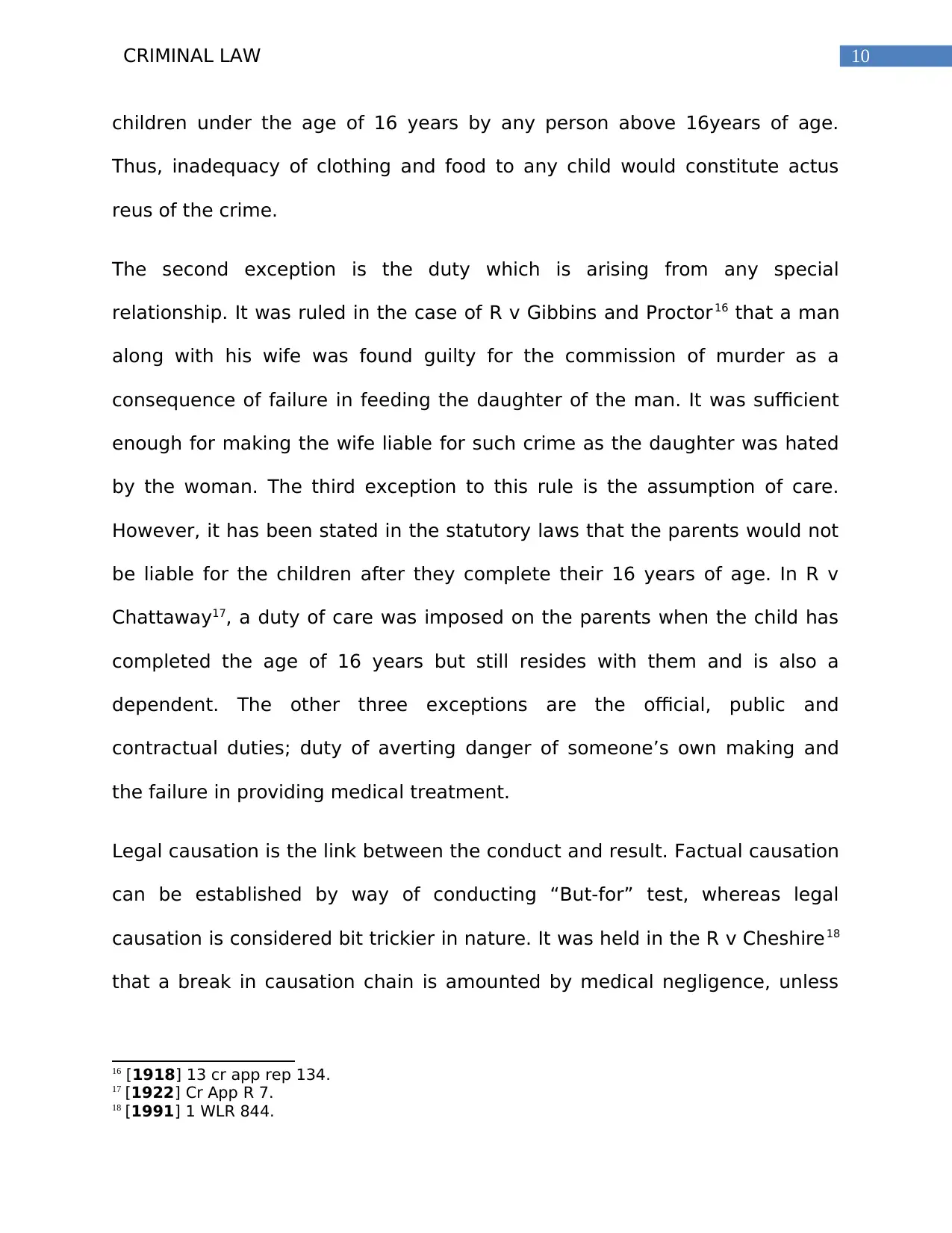
10CRIMINAL LAW
children under the age of 16 years by any person above 16years of age.
Thus, inadequacy of clothing and food to any child would constitute actus
reus of the crime.
The second exception is the duty which is arising from any special
relationship. It was ruled in the case of R v Gibbins and Proctor16 that a man
along with his wife was found guilty for the commission of murder as a
consequence of failure in feeding the daughter of the man. It was sufficient
enough for making the wife liable for such crime as the daughter was hated
by the woman. The third exception to this rule is the assumption of care.
However, it has been stated in the statutory laws that the parents would not
be liable for the children after they complete their 16 years of age. In R v
Chattaway17, a duty of care was imposed on the parents when the child has
completed the age of 16 years but still resides with them and is also a
dependent. The other three exceptions are the official, public and
contractual duties; duty of averting danger of someone’s own making and
the failure in providing medical treatment.
Legal causation is the link between the conduct and result. Factual causation
can be established by way of conducting “But-for” test, whereas legal
causation is considered bit trickier in nature. It was held in the R v Cheshire18
that a break in causation chain is amounted by medical negligence, unless
16 [1918] 13 cr app rep 134.
17 [1922] Cr App R 7.
18 [1991] 1 WLR 844.
children under the age of 16 years by any person above 16years of age.
Thus, inadequacy of clothing and food to any child would constitute actus
reus of the crime.
The second exception is the duty which is arising from any special
relationship. It was ruled in the case of R v Gibbins and Proctor16 that a man
along with his wife was found guilty for the commission of murder as a
consequence of failure in feeding the daughter of the man. It was sufficient
enough for making the wife liable for such crime as the daughter was hated
by the woman. The third exception to this rule is the assumption of care.
However, it has been stated in the statutory laws that the parents would not
be liable for the children after they complete their 16 years of age. In R v
Chattaway17, a duty of care was imposed on the parents when the child has
completed the age of 16 years but still resides with them and is also a
dependent. The other three exceptions are the official, public and
contractual duties; duty of averting danger of someone’s own making and
the failure in providing medical treatment.
Legal causation is the link between the conduct and result. Factual causation
can be established by way of conducting “But-for” test, whereas legal
causation is considered bit trickier in nature. It was held in the R v Cheshire18
that a break in causation chain is amounted by medical negligence, unless
16 [1918] 13 cr app rep 134.
17 [1922] Cr App R 7.
18 [1991] 1 WLR 844.
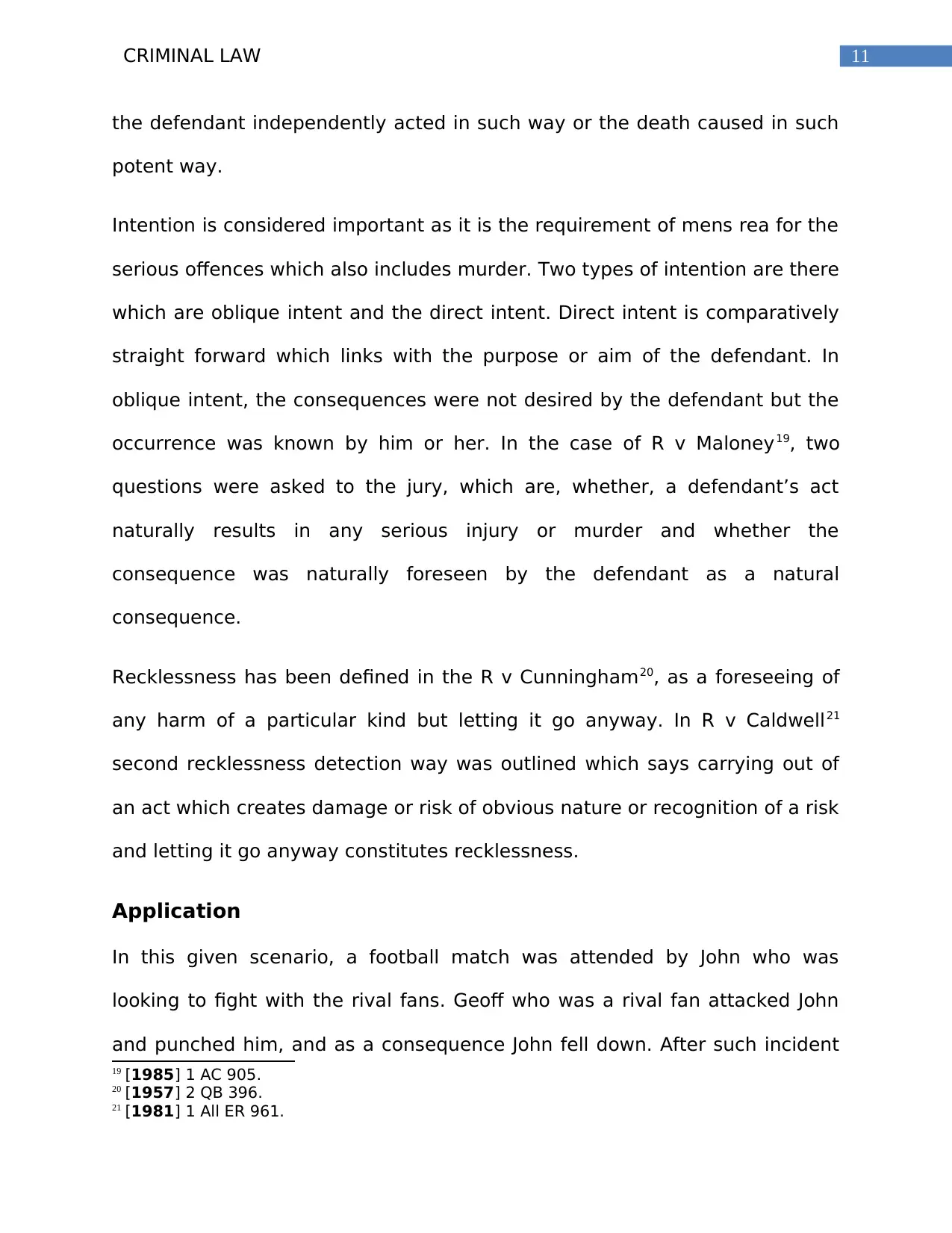
11CRIMINAL LAW
the defendant independently acted in such way or the death caused in such
potent way.
Intention is considered important as it is the requirement of mens rea for the
serious offences which also includes murder. Two types of intention are there
which are oblique intent and the direct intent. Direct intent is comparatively
straight forward which links with the purpose or aim of the defendant. In
oblique intent, the consequences were not desired by the defendant but the
occurrence was known by him or her. In the case of R v Maloney19, two
questions were asked to the jury, which are, whether, a defendant’s act
naturally results in any serious injury or murder and whether the
consequence was naturally foreseen by the defendant as a natural
consequence.
Recklessness has been defined in the R v Cunningham20, as a foreseeing of
any harm of a particular kind but letting it go anyway. In R v Caldwell21
second recklessness detection way was outlined which says carrying out of
an act which creates damage or risk of obvious nature or recognition of a risk
and letting it go anyway constitutes recklessness.
Application
In this given scenario, a football match was attended by John who was
looking to fight with the rival fans. Geoff who was a rival fan attacked John
and punched him, and as a consequence John fell down. After such incident
19 [1985] 1 AC 905.
20 [1957] 2 QB 396.
21 [1981] 1 All ER 961.
the defendant independently acted in such way or the death caused in such
potent way.
Intention is considered important as it is the requirement of mens rea for the
serious offences which also includes murder. Two types of intention are there
which are oblique intent and the direct intent. Direct intent is comparatively
straight forward which links with the purpose or aim of the defendant. In
oblique intent, the consequences were not desired by the defendant but the
occurrence was known by him or her. In the case of R v Maloney19, two
questions were asked to the jury, which are, whether, a defendant’s act
naturally results in any serious injury or murder and whether the
consequence was naturally foreseen by the defendant as a natural
consequence.
Recklessness has been defined in the R v Cunningham20, as a foreseeing of
any harm of a particular kind but letting it go anyway. In R v Caldwell21
second recklessness detection way was outlined which says carrying out of
an act which creates damage or risk of obvious nature or recognition of a risk
and letting it go anyway constitutes recklessness.
Application
In this given scenario, a football match was attended by John who was
looking to fight with the rival fans. Geoff who was a rival fan attacked John
and punched him, and as a consequence John fell down. After such incident
19 [1985] 1 AC 905.
20 [1957] 2 QB 396.
21 [1981] 1 All ER 961.
⊘ This is a preview!⊘
Do you want full access?
Subscribe today to unlock all pages.

Trusted by 1+ million students worldwide
1 out of 22
Related Documents
Your All-in-One AI-Powered Toolkit for Academic Success.
+13062052269
info@desklib.com
Available 24*7 on WhatsApp / Email
![[object Object]](/_next/static/media/star-bottom.7253800d.svg)
Unlock your academic potential
Copyright © 2020–2025 A2Z Services. All Rights Reserved. Developed and managed by ZUCOL.





